Published 2025-07-30
Keywords
- Optical Communication,
- Deep-Space Communication,
- Mars Missions,
- STK,
- Interplanetary Communication
How to Cite
Copyright (c) 2025 International Journal of Advanced Research and Interdisciplinary Scientific Endeavours

This work is licensed under a Creative Commons Attribution 4.0 International License.
Abstract
This research explores the feasibility of optical (laser) communication for Earth-Mars interplanetary missions, addressing the limitations of traditional radio frequency (RF) systems, such as bandwidth constraints and high latency. Using AGI’s System Tool Kit (STK), a simulation model was developed with an Earth ground station (DSS-14 Goldstone), a Mars orbiter relay, and a Mars surface station. Key parameters, including a 193.5 THz frequency, 10 Mbps data rate, and QPSK modulation, were configured to replicate real-world conditions. The simulation confirmed stable line-of-sight connectivity and successful dual-hop communication via the Mars orbiter. Despite software limitations preventing a full link budget analysis, the results demonstrate optical communication as a viable high-speed alternative for deep-space missions. This study provides a foundation for future research on hybrid RF-optical systems and advanced protocols to enhance interplanetary networks. The simulation also highlighted the importance of orbit selection and synchronization for minimizing communication outages during planetary rotation and eclipses. This research not only supports the adoption of optical communication in next-generation missions but also emphasizes the role of advanced simulation tools in evaluating system performance. The findings contribute to ongoing efforts in deep-space communication planning and pave the way for future hybrid RF-optical network designs with enhanced reliability, scalability, and data throughput.


